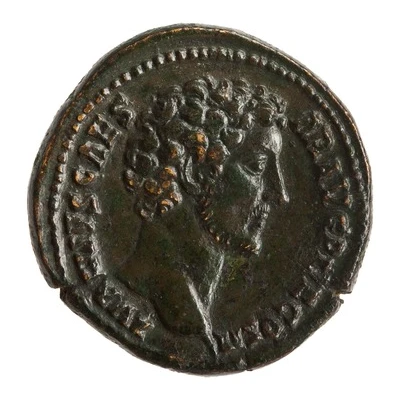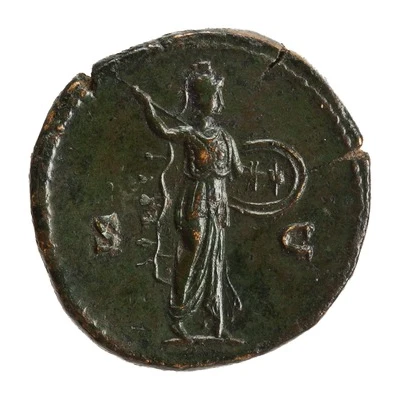


© American Numismatic Society (ANS)
Dupondius - Marcus Aurelius S C; Minerva
145 year| Bronze | 12.8 g | 27.5 mm |
| Issuer | Rome › Roman Empire (27 BC - 395 AD) |
|---|---|
| Emperor | Antoninus Pius (Titus Aelius Hadrianus Antoninus Pius) (138-161) |
| Type | Standard circulation coin |
| Year | 145 |
| Value | 1 Dupondius = ⅛ Denarius |
| Currency | Denarius, Reform of Augustus (27 BC – AD 215) |
| Composition | Bronze |
| Weight | 12.8 g |
| Diameter | 27.5 mm |
| Shape | Round (irregular) |
| Technique | Hammered |
| Demonetized | Yes |
| Updated | 2024-10-06 |
| Numista | N#261803 |
|---|---|
| Rarity index | 97% |
Reverse
Minerva, helmeted, draped, wearing cloak with aegis, advancing right, brandishing javelin in right hand and holding shield in left.
Script: Latin
Lettering: S C
Translation:
Senatus Consultum.
Decree of the senate.
Comment
Mass varies: 10.906–14.62 g;Diameter varies: 27.22–28 mm;
Example of this type:
American Numismatic Society (ANS)
Source:
Online Coins of the Roman Empire (OCRE)
Interesting fact
The Dupondius was a bronze coin introduced by the Roman Empire during the reign of Emperor Marcus Aurelius (161-180 AD). It was equal in value to two sestertii or one-fourth of a denarius, which was the standard silver coin of the time. The Dupondius was widely used throughout the empire and remained in circulation until the 4th century AD. The obverse of the coin features the bust of Marcus Aurelius, while the reverse depicts Minerva, the Roman goddess of wisdom, war, and crafts. The coin's design was meant to symbolize the emperor's wisdom and leadership, as well as the empire's military prowess and cultural achievements. Overall, the Dupondius - Marcus Aurelius (S C; Minerva) (145) coin is an interesting piece of history that provides insight into the economic, social, and political landscape of the Roman Empire during the 2nd century AD.